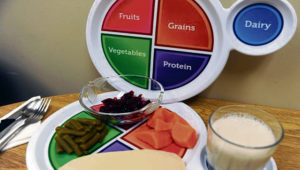 Nutrition is a critical element in the Total Force Fitness strategy to main a medically ready force. It plays a big part in the force’s overall readiness and performance because the nutritional choices we make affect every aspect of life, including sleep, mood, and performance.
Nutrition is a critical element in the Total Force Fitness strategy to main a medically ready force. It plays a big part in the force’s overall readiness and performance because the nutritional choices we make affect every aspect of life, including sleep, mood, and performance.
“Eating healthy can empower individuals to make good choices, which influences both readiness and their overall health,” said Navy Lt. Cmdr. Melissa Amescua, a registered dietitian and manager of the Navy nutrition program at the 21st Century Sailor Office. “Eating healthy keeps us mentally prepared and physically fueled to take on any situation that comes at us at any time.”
For children, its important parents and caretakers set the example by eating healthy with their kids and by providing healthy foods for the children to eat. “Food provides our children with energy to grow, concentrate, the ability to play, and to perform,” she said. “All things that are needed for them to be successful in school and at home.”
Keeping children healthy by providing the right foods for them is also critical for prevention. “Our brain needs good nutrition to manage stress, maintain alertness, and optimize physical and cognitive performance,” said Amescua. “Mentally, just like our warfighters, they can perform so much better with nourishment because the food they consume affects their brain development.”
Additionally, “not eating healthy can lead to being more overweight and obese, which also increases the need for more medical care and the risk for musculoskeletal injuries,” she said. “It puts us at risk for having a diagnosis such as diabetes or heart disease and even puts us at risk for getting viruses such as COVID-19.”
The expert noted it’s not only important to make smart choices about what we feed kids, but also how much we feed them — portion sizes make a difference.
“Children should be eating a wide variety of nutrient-dense foods such as fruits, vegetables, whole grains, beans, legumes, dairy, and lean proteins,” she said. “Avoiding or limiting foods daily that are high in sugar, unhealthy fats, and many pre-packed processed foods may also need to be limited.”
To meet their nutritional needs, she said most children should eat three meals and at least one snack during the day. Resources such as myplate.gov and the U.S. Department of Agriculture’s 2020-2025 Dietary Guidelines for Americans can help make smarter choices.
Additionally, Amescua recommends the 10 tips below for military parents and families to encourage kids to make smarter nutritional choices:
Be a role model. Children are more likely to eat foods that their parents eat while they are growing up. This means if the parent does not eat brussels sprouts, then nine times out of 10 the kids won’t either. To get kids to choose healthy foods, adult family members must choose them too.
Encourage drinking water. Ensure your child is drinking water throughout the day, understanding that if they have juice that 4 ounces or half a cup of 100 percent juice is a serving. Kids who drink soda, energy drinks, or some types of juices consume mostly sugar and other ingredients such as caffeine that they do not need. These drinks encourage obesity, poor attentiveness, and even decrease calcium consumption.
Portion control. Your portion is not always their portion. Understand what a portion size looks like for you and for them, so they do not consume more than what their small bodies need. Excess calories can cause weight gain.
Make time for family mealtime. Research shows that families that eat together live a healthier lifestyle. Family meals can help prevent obesity because they eat more slowly and talk more.
Eat breakfast. Encouraging your child to have a healthy breakfast daily can help with how they perform in school during the day. Breakfast equals brain power.
Choose healthy snacks for kids. Most children eat at least one snack per day. Use snack time to increase fruits and vegetable intake, keep different healthy snacks available, and avoid processed foods and added sugars when possible.
Teach your children to eat a rainbow of colors. Different foods provide different vitamins and minerals that are very important. Talk about where food comes from and how it helps nourish their bodies.
Don’t give up with those picky eaters. It can take 10 to 15 times for a child to like a new food – if they do not like it now do not give up. Implement the two-bite rule, where they must at least try the food. Remember children’s tastebuds change as they get older: When they are young, they are very strong, hence they do not like many foods, but the older they get the more likely they are to like new foods in different ways.
Avoid using food as a reward. If parents give ice cream or a dessert as a reward for good grades or good behavior, it enforces unhealthy behaviors of eating every time they do well. Instead of giving them a sweet treat, buy them a new book, toy, or take them to a movie or find time to do their favorite activity with them.
Involve them in meal planning, grocery shopping, and filling their lunch box. The more children feel a part of the meal and that they contributed to it, the more likely they will eat it with others. Also, remember to ask them to try new foods and incorporate their ideas into the meal preparation.


